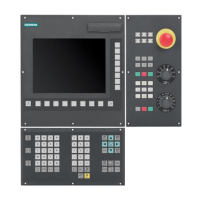Programming
8.7 Arithmetic parameters R, LUD and PLC variables
8-178
SINUMERIK 802D sl Operation and Programming Nibbling (BP-N), 06/2006 Edition
6FC5 398-3CP10-0BA0
Within the program, the individual field elements can be reached via the field index and can
be treated like individual variables. The field index runs from 0 to a small number of the ele-
ments.
Example:
N10 PVAR7[2]=24 ; The third field element (with index 2) is assigned the value of 24.
Value assignment for a field having a SET instruction:
N20 PVAR5[2]=SET(1,2,3) ; From the 3rd field element on, different values are assigned.
Value assignment for a field having a REP instruction:
N20 PVAR7[4]=REP(2) ; Starting from field element [4], all elements are assigned the same
value, here 2.
8.7.3 Reading and writing PLC variables
Functionality
To allow rapid data exchange between NC and PLC, a special data area exists in the PLC
user interface with a length of 512 bytes. In this area, PLC data are compatible in data type
and position offset. In the NC program, these compatible PLC variables can be read or writ-
ten.
To this end, special system variables are provided:
$A_DBB[n] ; Data byte (8-bit value)
$A_DBW[n] ; Data word (16-bit value)
$A_DBD[n] ; Data double-word (32-bit value)
$A_DBR[n] ; REAL data (32-bit value)
“n” stands for the position offset (beginning of data area to beginning of variable) in
bytes
Example:
R1=$A_DBR[5] ; Read REAL value, offset 5 (starts at byte 5 of the range)
Information
S The reading of variables generates a preprocessing stop (internal STOPRE).
S A maximum of 3 variables can be written simultaneously (in a block).

